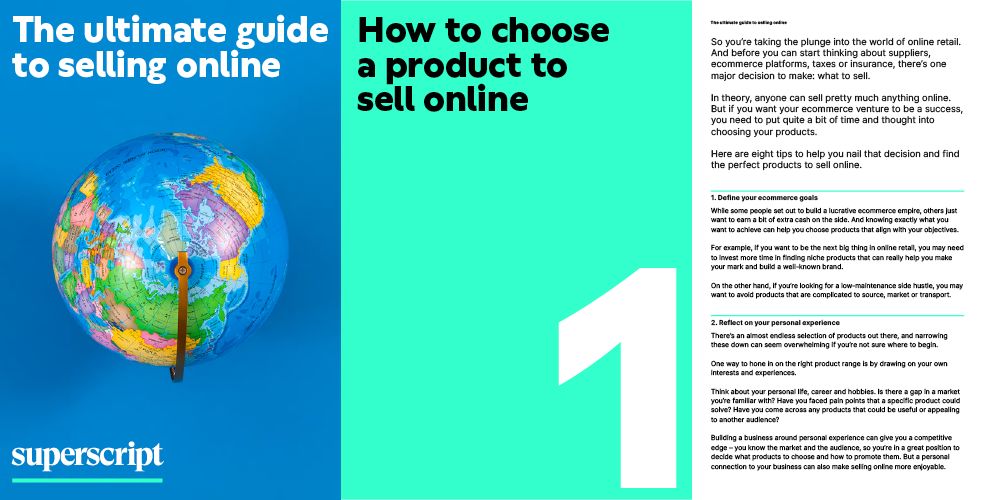
The ultimate guide to selling online
All you need to know about setting up a successful business selling online, from picking products and platforms to navigating taxes and understanding company structures.
Download your free guide to selling online
It's quick, instant and unlocks 11 chapters of valuable advice for online retailers and ecommerce businesses.
What's inside the ultimate guide to selling online?

1) How to choose a product to sell online
In theory, anyone can sell pretty much anything online. But if you want your ecommerce venture to be a success, you need to put quite a bit of time and thought into choosing your products.
We've got eight tips to help you nail that decision and find the perfect products to sell online.
2) How to pick the right supplier
Once you’ve settled on what products you’re going to sell, you’ll need to find the right business to supply those products.
We explore some of the key things to consider when picking a supplier.
3) Five of the best ecommerce platforms
When taking the leap into the world of online retail, one of the most important decisions to make is where you'll sell your products.
More than two-thirds of online retail businesses do this using third-party ecommerce platforms. But with so many options out there, how do you decide which is best for you? In this chapter, we review five of the most popular options.
4) Common barriers to success for dropshippers
Dropshipping is becoming increasingly popular, especially among side hustlers, with a third of online stores now using the dropshipping model. If you're one of the thousands of entrepreneurs exploring this business model, we break down some of the most significant barriers to success you’ll need to overcome.
5) Setting up – sole trader vs limited company
You’ve nailed your product selection, you’ve sourced a supplier and you’ve found the perfect platform for selling your goods. Next up: deciding which company structure you’re going to opt for.
There are a number of different company structures in the UK, but the two most common for new online retail businesses are as a sole trader or a limited company. So what are the differences?
6) How to complete your Self Assessment
Self Assessment is a system used by HMRC to collect Income Tax and claim tax relief for individuals and sole traders.
If you’ve never submitted a Self Assessment before, it can seem daunting at first. So we’ve put together some key information and top tips to help make the task less taxing.
7) Registering for VAT
VAT (Value Added Tax) is one of the most important forms of taxation for online retailers to understand. This is because while the economic burden of paying VAT falls on consumers, it’s the sellers of products who are responsible for actually paying the tax to the government, after adding it to the prices they charge.
8) Importing products
What extra steps do you need to take if your business sells import products from overseas to sell on to the UK market?
9) Exporting products
If you wish to sell your products online to customers overseas, you’ll need to abide by the UK’s laws and regulations surrounding the export of goods. In this chapter, we explore the procedure for exporting goods internationally.
10) Securing insurance for selling online
When we asked online retailers about their business insurance, a whopping 44% said they don’t have any insurance to cover their business activities or products. We break down why business insurance is an important factor in building a successful online retail business.
11) How to get customer reviews
Once your online selling business is set up, it’s time to start building a reputation online. Online reviews are powerful for any business, but especially for retailers that operate in the online world and they can solidify your business’ reputation and attract new customers.
Authorised by the FCA
The FCA supervises UK financial services firms to protect consumers. We are directly authorised and regulated by the FCA and our Firm Reference Number is 656459. These details can be confirmed on the Financial Services Register at www.fca.org.uk or by calling the FCA on 0845 606 1234.
A-rated financial strength
Our insurance products are underwritten by Standard & Poor’s A-rated financial strength or higher. This means the underwriter has been independently assessed by the world’s leading credit rating provider and found to have a strong capacity to meet financial commitments (pay claims).
Protected by the FSCS
If you are a business with an annual turnover under £1m, charity with an annual income under £1m, or trust with net assets under £1m, then you will be entitled to compensation from the FSCS in the unlikely event we cannot meet our obligations. Full details and further information on the scheme are available at www.fscs.org.uk.
